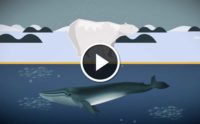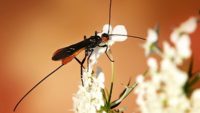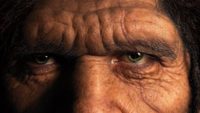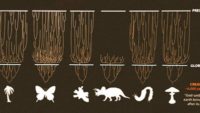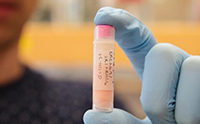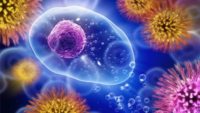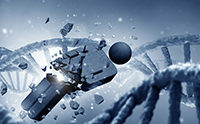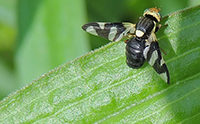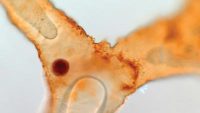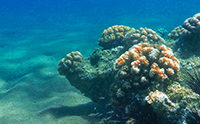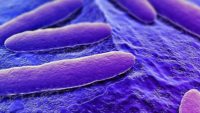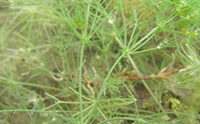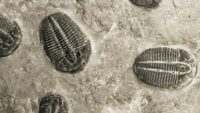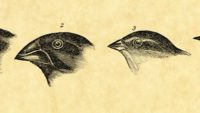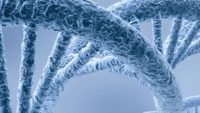In 1859, Darwin speculated that bears evolved into whales. But does this story hold water? More… …read more Source: icr.org
By Dr. Elizabeth Mitchell Many parasitoid wasps optimize the reception for their larvae by injecting venom that disables the host insect’s immune system or changes its behavior. …read more Source: AIG Daily
By Dr. Elizabeth Mitchell Scientists report the biochemical footprint of a particular sugar polymer—a type that modern humans cannot make—has been found in an ancient African fossil. …read more Source: AIG Daily
By Dr. David Menton Evolutionists seek to explain the origin of species from a single, hypothetical, primordial life-form by means of progressive change and natural selection. …read more Source: AIG Daily
Recently, secular scientists revealed their speculation of alternate evolutionary histories by studying a protein they supposed existed half a billion years ago. Using a large “set of genetic variants” from “a resurrected version of an ancient protein” they theoretically discovered “a myriad of other ways that evolution could have” occurred. Are they on to something valid or is this another unsupported speculation? More… …read more Source: icr.org
By Dr. Andrew Fabich Viruses are amazingly complex and beautiful machines. They exhibit all the hallmarks of being designed, though we often fail to recognize them as such. …read more Source: AIG Daily
Human designers of TV screen copy one of the ways cuttlefish change colour. …read more Source: creation.com
The recent publication of a research paper evoked such headlines as “Massive genetic study shows how humans are evolving.” Despite the improvement of health-care technology, many other studies indicate that chronic human disease is increasing worldwide—and that mutations are commonly associated with disease, not upward evolutionary improvement. More… …read more Source: icr.org
The controversial theory with a long history of competing concepts that is no closer to being resolved than it was in Darwin’s day. …read more Source: creation.com
Does the reverse ontological argument show that God can’t exist? …read more Source: creation.com
It’s claimed to be ‘evolutionary art’, but evolution has no plausible explanation for incredible images on the wings of a remarkable fly. …read more Source: creation.com
Recent studies describing sophisticated plant traits, and some of the insects that feed on those plants, highlight how biology may be interpreted very differently. But usually, these interpretations are largely dependent on a researcher’s preexisting beliefs about the origins of living things. More… …read more Source: icr.org
Evolutionists try to define homology by how it is explained, not by how it is observed. …read more Source: creation.com
Everyone knows that spiders spin webs but did you know they also use their silk to move through the air? …read more Source: creation.com
By Ken Ham Evolutionist Dr. Mary Schweitzer shocked the world in 2005 when she discovered Did dinosaurs roam the earth 65 million years ago? This Echoes Of The Jurassic book and DVD pack shows new discoveries with evidence for creation and biblical accuracy of Genesis. Shop Now You can learn more about these remarkable finds in the brand-new DVD Echoes of the Jurassic. This eye-opening DVD, hosted by David Rives, features over a dozen Bible-believing scientists, including some of AiG’s own, who give a clear and concise understanding of both the science and the controversy surrounding the ages of these [More]
Corals are thought to be one of the earliest forms of multicellular life to have evolved. Today, corals are foundational to ocean life, but are they primitive? A new study shows that a highly complex system of genetic recoding called RNA editing is active in today’s corals. Does this fit the evolution model or the creation model? More… …read more Source: icr.org
By Ken Ham Do “molecules of ancient organisms” from Australian rocks answer the question of man’s origin? Well, this recent article suggests that we humans owe our existence to . . . algae. Supposedly, it’s only because algae formed that life was able to evolve and diversify so, they say, “algae . . . are the ancestors of us all.” After all, evolutionists believe humans are related to all animals and plants in their so-called evolutionary tree of life. According to this new story about the origin of life, bacteria dominated the planet in the supposed Snowball Earth period, a [More]
The discovery in a seaweed of a complex molecule thought (and taught!) to be only in land plants astonishes evolutionists, forcing a billion-year rewrite of textbooks. …read more Source: creation.com
By Dr. Elizabeth Mitchell A group of scientists at Tel Aviv University propose that bacteria in our intestines may be responsible for human altruism. …read more Source: AIG Daily
Botanists recently discovered a large form of green algae named Lychnothamnus barbatus in North American lakes. Before this discovery the only hints of this particular type of algae in the Americas came from their fossils mixed with dinosaurs in Argentina. Somehow, it avoided evolutionary tinkering for over “65 million years.” More… …read more Source: icr.org
Scientists finally discover how the female argonaut really uses its shell …read more Source: creation.com
By Dr. David Menton Since the time of Darwin, evolutionists have looked to the fossil record for historical evidence of evolution. …read more Source: AIG Daily
By Avery Foley Reports proclaim human actions, in this case the building of a hydro-electric dam, are “messing with evolution” because of changes in a species of gecko. …read more Source: AIG Daily
By Avery Foley Our tongues can sense five basic tastes with specialized nerve cells for each. A new study suggests our tongues can detect another “taste”—tasteless water. …read more Source: AIG Daily
Microbes-to-man evolution is often an unnecessary add-on to explanations in biology. …read more Source: creation.com
By Ken Ham The story (or fairy tale) of how evolution occurred is always changing. It seems every news item carries a different story from the previous one! For example, evolution is supposed to be “survival of the fittest,” with the toughest and strongest surviving and the weak dying out—unless it’s not. Let me explain. According to new studies, “tameness” was supposedly selected for in human evolution, resulting in genetic changes as we “domesticated” ourselves. One researcher suggests that over the last alleged 200,000 years “humans began acquiring skills which would have allowed early humans to gang up against bullies. [More]
By Dr. Nathaniel T. Jeanson Frello criticizes papers that he hasn’t carefully read. Not surprisingly, his objections turn out to be unfounded. …read more Source: AIG Daily





















